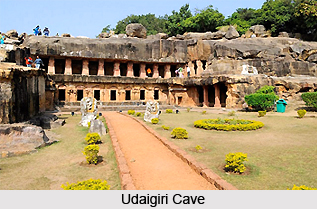 Udaigiri is one of the most famous Buddhist pilgrimages in the state of Odisha, which is special due to its caves and was a flourishing learning centre of Buddhism in past. The caves at Udaigiri house some of the most ancient sculptures of Buddhist origin. The place is not far from Cuttack and Bhubaneshwar and it still reveals the rich history of ancient time through the antediluvian monasteries, stupas and other Buddhist structures found at this place. Even the hill standing as a backdrop to the caves was ornamented with inscriptions and rock-cut sculptures.
Udaigiri is one of the most famous Buddhist pilgrimages in the state of Odisha, which is special due to its caves and was a flourishing learning centre of Buddhism in past. The caves at Udaigiri house some of the most ancient sculptures of Buddhist origin. The place is not far from Cuttack and Bhubaneshwar and it still reveals the rich history of ancient time through the antediluvian monasteries, stupas and other Buddhist structures found at this place. Even the hill standing as a backdrop to the caves was ornamented with inscriptions and rock-cut sculptures.
History of Udaigiri
Udaigiri was considered as a prominent learning centre of Buddhism and several caves and stupas excavated from the land stand witnesses of the earlier prosperity. A Buddhist Triangle is set in Udaigiri, along with Lalitagiri and Ratnagiri. Jains also consider Udaigiri as a holy place. These caves are built up of coarse grainy sandstone material, where the great Jain King Kharavela (168 to 153 B.C) modelled some sculptures. These Udaigiri - Rani Gumpha caves served as abodes for the Jain monks. Udaigiri literally means `Hills of Sunrise`. There are almost hundred and thirteen caves, which have immense archaeological significance because of the Pali records engraved in `Hathi Gumpha` and megalithic records of king Kharavela.
Attractions of Udaigiri
The caves occupy a fairly large area around the south of the Udaigiri hill. Cave number one is `Rani Gompa` or `Rani Ka Naur`(cave of queen), which is adorned with spectacular sculptures of elephants, monkeys, sword fights and abduction of women, all of which are linked with King Kharvela. Cave number three and four are double-storied and they are famous for the magnificent sculptures as well as architectural simplicity.
The sculptures include images of lion and its prey, elephants with snakes around them and some unusual creatures of animals with winged body sitting at the top of pillar. The `Ganesha Gumpha` or cave number ten is facing directly the Rani Gumpha, where there is elephant headed Lord Ganesha on the rear wall of the cell. There is cave 14or `Pavana Gumpha` (Cave of Purification) and the small Sarpa Gumpha (Servant Cave), whose tiny door is surmounted with a three-headed cobra. There is also a `Dev Sabha`, where the entire area is covered with thousands of relics scattered here and there. An ancient tank is also located here whose holy water is called `Akash Ganga`(Ganga from the Heavens).
Several inscriptions were chiselled on the caves and a number of inscriptions are found in the Hathi Gumpha, which depict that the Chedi dynasty ruled Kalinga from their own capital.
Apart from these, a recent excavation proves the existence of a monastery namely the Madhavapura Mahavihara in Udaigiri. The Madhavapura Mahavihara monastery is decked with numerous brilliant sculptures by the Buddhists. Moreover, Hieun Tsang, the Chinese traveller to India, has mentioned ample references of Udaigiri in his travelogue. As per this Chinese traveller, a number of monasteries were situated by the Buddhists in the ancient times. Numbers of ancient inscriptions, brick stupas and carved sculptures are the things that Udaigiri caves and monasteries flaunt.
Udayagiri also consists of a brick stupa, two brick monasteries, a beautiful stepped-stone decorated with inscriptions on it, and also rock-cut sculptures atop the hill behind.
Connectivity of Udaigiri
Udayagiri is located in the Jajpur district of Odisha, India and can be visited by making either Bhubaneswar or Cuttack a base. Bhubaneswar has a domestic airport and is connected to other major cities like Delhi, Kolkata, Mumbai, Chennai, Visakhapatnam, Nagpur and Hyderabad.
The city is also connected by fast and superfast trains to all important destinations in the country including Kolkata, Guwahati, Delhi, Chennai, Hyderabad, Mumbai, Bengaluru, Thiruvanantpuram. From Bhubaneswar, Udaigiri Buddhist complex can be reach by car, taxi or auto rickshaw.



















